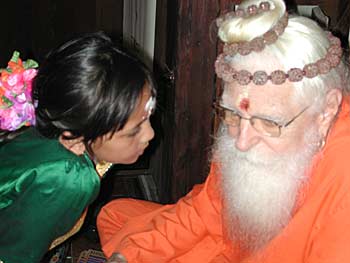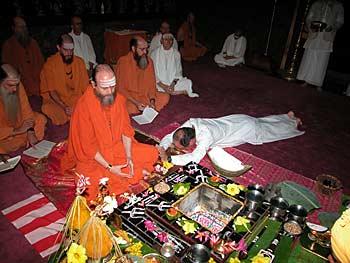Blog Archives

Young children everywhere all over the world, for some reason, were not shy of Gurudeva. He had such a “nothing to fear here” aura about him that they would often take the initiative, even without suggestion, to approach him and tell their secrets and ask questions. He always listened very attentively.
Speaking of children, check out today’s sampling of Mystic Mouse Coloring book.
And, we are happy to announce a new web site for teachers and parents who would like to order bulk copies for classes at a super discount. Click here to get five copies or more in one order.
Or Click here to get your single copy to bring the values of Sanatana Dharma into the world of children and young people.
Our Beloved and Revered Satguru Sivaya Subramuniyaswami
Attained Maha Samadhi on November 12th, 2001
Click to read for Details.
Mystic Mouse Coloring Book Now available
Today’s sample page. —– Click here to get your copy today!

Bodhinatha at our Sun One Homa today just before the fire is started. The devotees come forward to prostrate and touch his feet, just as they had done with Gurudeva to receive the blessings of the Kailasa Parampara. Everyone feels Gurudeva’s presence strongly when they enter Kadavul Temple.
Cybertalk: Part 4 of 4: Bodhinatha continues his talk on vratas by
elucidating the dasama bhaga vrata, the tithing vow. This vow relates to our
finances, but at a deeper level it has the power to harness desire for the
sake of the stability of one’s whole family. In conclusion he speaks about
how the devas look at our vratas and how vows can effect a positive change
on our karma.
Cybertalk Ends”
For more information about listening to Gurudeva’s talks online and to hear them in other formats, click here.
And click here for an Index to All Past CyberTalks.
Study Gurudeva’s teachings
every day. Visit the Master Course site!
Bodhinatha will be happy to hold “Prasnottara Satsang” — “Questions and Answers” over the telephone with any Hindu religious societies, Hindu youth groups, Radio talk show hosts etc. All you need is a phone with a speaker and an enthusiastic audience. Arrangements may be made in advance by sending email to Sadhaka Mahadevan
If you are experiencing any problems listening to the audio, please to go our Audio FAQ page for sound geeks and follow the directions there.
 |
|
|
 |
||
The ancient Vedic fire ceremony was a widespread phenomenon in ages past. There is archeological evidence that even as far north as Finland and the Baltic sea, fire altars are to be found that are similar to the ones we see in India today. In Russia there is one of the few indigenous peoples who have held their spiritual traditions intact throughout history and who still have a high priest in an unbroken line going back into the mists of time. They have a sacred grove in which they too perform fire ceremonies. What we know as Vedic culture at one time clearly spanned vast continents, many thousands of years ago.
The Vedas hailed the God of Fire, Agni as the “Messenger of the Gods” whose ministerial duty was to convey, not only offerings to the heavens, but, along with them, the thoughts, prayers and devotion of the devotees, upon receipt of which the Gods and inner plane beings respond.
The Sacred Ghee Ladle is carved from a single piece of wood. At the end is a large cavity to hold the clarified melted butter, often ornately carved as in this case. At the tip of the ladle a hole is bored through which the melted butter can be carefully poured into the fire. At the very end of the ceremony, the final offering consists of a betel leaf with grains, flowers and a banana on top of the ladle, which are all offered into the fire in one gesture.
The offerings to be used in the fire ceremonies are carefully detailed in the Vedas. And every ceremony is conceived to have a specific result based on the “sankalpa” or intention behind it’s performance. Generally the ceremony is to connect the three worlds, the physical, astral and casual, so that spiritual energy floods out into the temple and surrounding properties. Other ceremonies may be performed for very specific purposes: for rain, to bless a new temple opening, to bless a house, etc.
Bodhinatha gave a powerful talk this morning in which he touched on the all important issue of daily sadhana and what it really means. He said obviously the first stage is just to get up early enough every day to actual have a period of sadhana in one’s life. Many people get on the path and then they lapse and go for years, not doing any daily sadhana at all.
But for those disciplined persons who actually do get up five times a week for sadhana, the all important question is, are you actually improving? He spoke powerfully and practically about “comparing yourself to yourself, not to others, but to yourself as you were a few years ago… have you improved? Are you actually putting the teachings into action in your life?” This is a not to be missed talk! Stay tuned in the days ahead for the audio.
Aunti Puna Dawson and fellow staff members of the Hawaiian Cultural Charter School on Kauai came to the monastery today to visit. They brought a group of children from the Lihue Court Town Home housing development. It was a radiant group of young people.
We took them into the publications facility where they were quite impressed with the extent of technology amassed inconspicuously under a mango tree by the Wailua River!
As usual, the older children were full of questions and attentive as Sannyasin Arumugaswami talked about the our magazine Hinduism Today, while the younger kids were more interested in what kind of camera we had…
Everyone enjoyed a trip to the temple site to meet the silpies and see the giant stones.
The children were quite serious in demeanor, but full of questions:
Child: “What’s your name”
Monk: “My name is Yogi Mahadevan.”
Child: “Are you real?”
Yogi Mahadevan: “Oh yes, I am real.”
Child: “That man, Gurudeva, he passed away 1 year ago. My father also went to heaven. Why do people have to die?”
Monk: “Well, they don’t really die. They are still alive, but their soul just went to the inner world.”
The always exciting discovery of Rudraksha fruits.
A typical Kauai summer day with bright sun interspersed with five-minute showers blowing in with gentle easterly trade winds. This shot of the Iraivan temple from the monastery amidst a downpour gives a sense of the vision of the temple implanted in the botanical wonderland which is our beautiful San Marga land. Make plans for your pilgrimage today!
|
MORE UPLIFTING THINGS |
Innersearch 2002 in Hawaii!
Our next Innersearch Travel-Study program will be held right here on the island of Kauai in the summer of 2002. It’s the first such program on the Garden Island since 1974! From July 17 to July 22 we will enjoy daily classes with the swamis, join in the annual Guru Purnima festival, be inspired by local culture, explore the lush tropical island in exciting and non-touristy ways, and more. Be prepared for a wonderful spiritual experience in paradise with meditations, seminars and sacred ceremonies at the Siva temple of Kauai’s Hindu Monastery. Many have applied already, and there is a limit of 50 participants, so we recommend everyone apply as soon as possible. Interested? Please request an application from pilgrim@searchbeyond.com |
|

|
Check our children and youth section for new items for the young and young at heart! | |
|
1. SIGN OUR GUESTBOOK and receive a FREE GIFT |
||
| 2. Newest Book: LIVING WITH SIVA | ||
|
3. Visiting KAUAI’S HINDU MONASTERY |
||
|
4. Contribute to THANK YOU, GURUDEVA FUND |
||
From Our Gurus' Teachings
Archives are now available through 2001. Light colored days have no posts. 1998-2001 coming later.
